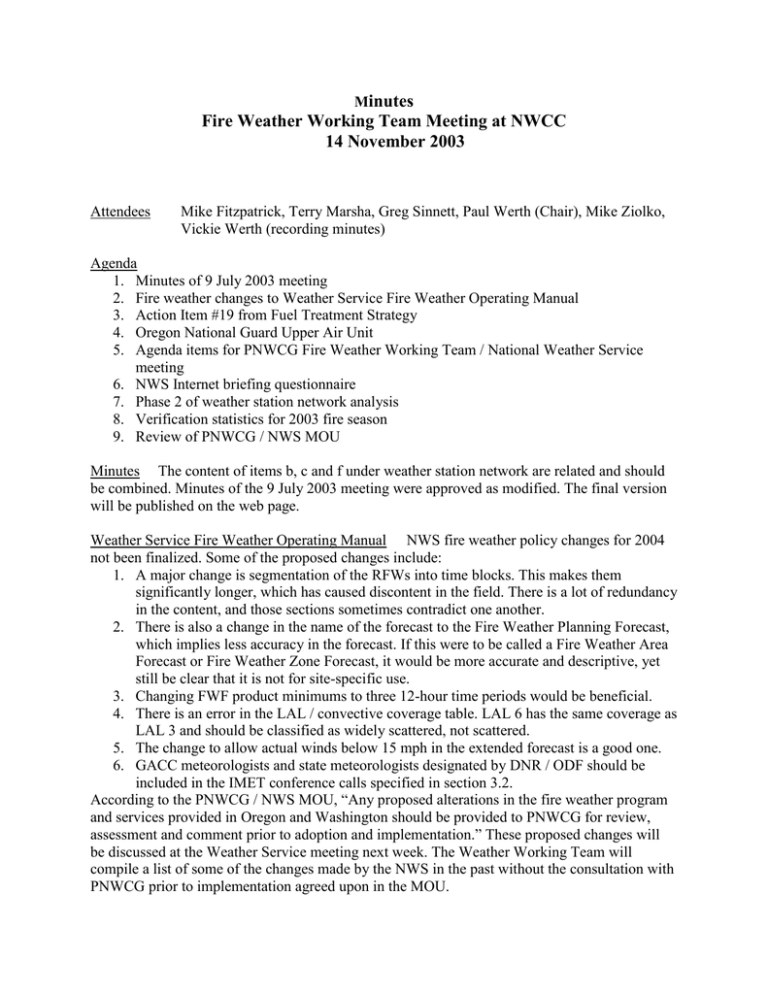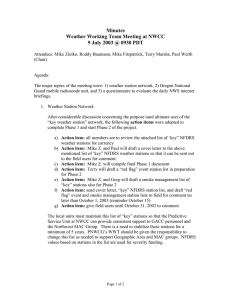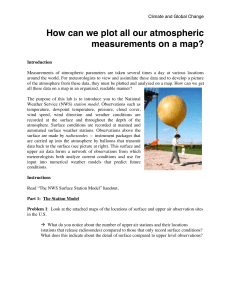inutes Fire Weather Working Team Meeting at NWCC 14 November 2003
advertisement

Minutes Fire Weather Working Team Meeting at NWCC 14 November 2003 Attendees Mike Fitzpatrick, Terry Marsha, Greg Sinnett, Paul Werth (Chair), Mike Ziolko, Vickie Werth (recording minutes) Agenda 1. Minutes of 9 July 2003 meeting 2. Fire weather changes to Weather Service Fire Weather Operating Manual 3. Action Item #19 from Fuel Treatment Strategy 4. Oregon National Guard Upper Air Unit 5. Agenda items for PNWCG Fire Weather Working Team / National Weather Service meeting 6. NWS Internet briefing questionnaire 7. Phase 2 of weather station network analysis 8. Verification statistics for 2003 fire season 9. Review of PNWCG / NWS MOU Minutes The content of items b, c and f under weather station network are related and should be combined. Minutes of the 9 July 2003 meeting were approved as modified. The final version will be published on the web page. Weather Service Fire Weather Operating Manual NWS fire weather policy changes for 2004 not been finalized. Some of the proposed changes include: 1. A major change is segmentation of the RFWs into time blocks. This makes them significantly longer, which has caused discontent in the field. There is a lot of redundancy in the content, and those sections sometimes contradict one another. 2. There is also a change in the name of the forecast to the Fire Weather Planning Forecast, which implies less accuracy in the forecast. If this were to be called a Fire Weather Area Forecast or Fire Weather Zone Forecast, it would be more accurate and descriptive, yet still be clear that it is not for site-specific use. 3. Changing FWF product minimums to three 12-hour time periods would be beneficial. 4. There is an error in the LAL / convective coverage table. LAL 6 has the same coverage as LAL 3 and should be classified as widely scattered, not scattered. 5. The change to allow actual winds below 15 mph in the extended forecast is a good one. 6. GACC meteorologists and state meteorologists designated by DNR / ODF should be included in the IMET conference calls specified in section 3.2. According to the PNWCG / NWS MOU, “Any proposed alterations in the fire weather program and services provided in Oregon and Washington should be provided to PNWCG for review, assessment and comment prior to adoption and implementation.” These proposed changes will be discussed at the Weather Service meeting next week. The Weather Working Team will compile a list of some of the changes made by the NWS in the past without the consultation with PNWCG prior to implementation agreed upon in the MOU. Fuel Treatment Strategy The PNWCG Fire Use and Fuels Management Working Team requested that this item be discussed at the Weather Service meeting. However, since Action Item #19 refers to state briefings, this is not something the National Weather Service can address. ODF and DNR Smoke Management Program Managers prefer that this issue be handled by the states. The Weather Working Team recommends that this issue be resolved through collaboration between ODF, DNR and the Fire Use and Fuels Management Working Team. Oregon National Guard Upper Air Unit The Oregon National Guard unit was not used during the 2003 fire season. A similar unit could have been used on the Okanogan had one been available, so the team will investigate whether such a unit is available in the Washington area. Agenda items for PNWCG Fire Weather Working Team / National Weather Service meeting A request has been received from the field that dry lightning be discussed at the meeting. It was determined that this should be addressed as problem lightning and discussed with the Red Flag criteria in agenda item 8. Note: The cost of securing lightning data is a problem for the states. Greg Sinnett has approached Phil Sielaff about the possibility of the National Association of State Forecasters arranging access to BLM lightning data, but no progress appears to have been made on such an agreement. Internet briefing questionnaire This is an on-going project that has not yet been completed. The deadline date for formulating procedures will be changed to 1 April 2004. Requests for an input protocol have been received from the field, so this is something that should be scheduled as a higher priority before that date. Phase 2 of weather station network analysis Terry Marsha distributed two lists resulting from queries based on five years of daily wind speed data recorded between midnight and 0800 for weather stations west of the Cascades and during the afternoon for stations east of the Cascades. A “W” next to the station denotes a good wind station. A “Y” indicates a key station useful in evaluating regional NFDRS levels. The second list details stations that appear to be neither good NFDRS nor wind data sources. An example of the value of these lists is Greenwater, which no longer appears to be a good wind station. This was a good wind station in the past, and this needs to be investigated to determine why it is not producing good wind information. These lists, along with a Weather Working Team cover letter, a complete report, and graphical data representations, will be sent to the field with a recommendation that anything with a W (good wind stations) or a Y (good for regional level NFDRS) be retained. Field personnel will be asked to identify which stations on the second list (apparently non-viable stations) are important to them. How well are the non-viable stations maintained? Can a process be established for reevaluation after improved maintenance? If these weather stations do not produce useful data after any recommended maintenance changes, are these stations worth continuing to finance and maintain? Since these stations appear to be of questionable value, field offices need to evaluate which stations are valuable for what purposes. This should assist field staff in preparing effective budgets for station maintenance. Areas already using this type of analysis have achieved significant savings during the past year by replacing some stations’ data with that received from other stations and eliminating the less valuable stations. Terry Marsha can prepare a five-year wind trend query for each station to be sent to the appropriate offices as appendices to the other two lists. Page 2 PNWCG Fire Weather Working Team Meeting 5/31/2016 Verification statistics for 2003 fire season Paul Werth distributed verification data sheets. 1. The color-coded matrix indicates the number of acres burned for each agency by year since 1970. They are sorted by year from largest to least number of acres burned. 2. A Red Flag Warning verification matrix has been prepared for each NWS office. Toward the bottom of each matrix in blue italics are missed warnings, followed by the total number of warnings, total number of events forecasted, and number of missed warnings. The false alarm rate (FAR), probability of detection (POD), and critical success index (CSI) was calculated for each of the NWS offices. The false alarm rate was high at a number of offices because there in a tendency to include all fire weather zones in a red flag warning rather than limiting the warning to the zones most likely to experience the event. According to the MOU, sixty percent of warnings should be preceded by watches. Five of the six Weather Service offices failed to meet the sixty percent requirement. In general, the Critical Success Index (which is based on the ratio of correct forecasts to the total number of correct forecasts plus missed warnings plus incorrect forecasts) was down this year and is far below National Weather Service Western Region 1999 values. Paul will graph this year’s data and compare it to Western Region 1999 data. 3. NFDRS forecast verification was distributed and discussed. All key stations, plus at least one additional station in each fire weather zone, were verified with respect to temperature, relative humidity and wind speed. A persistence error was calculated for each weather station and then compared to the forecaster error to determine the Forecaster Improvement over Persistence. Graphs were displayed for temperature, humidity and wind speed for the years 2000 through 2003. The final graph represents the number of NWS forecasts per station by office since 2000. The graph indicates that there has been consistent improvement in the frequency of fire-agency-provided weather observations to NWS. It would be helpful to have zone trends east of the Cascades provided by NWS beginning 1 June. Observed fire danger indices are tracked by the Northwest Interagency Coordination Center beginning 1 May, so it is important that data be entered for stations on a daily basis beginning that date unless there are extenuating circumstances. Some weather stations are not up and running as late as July. 4. The last matrix represents a verification of forecast ERCs and 100-hour fuel moistures for Southwestern Oregon produced by NWCC Predictive Services during the 2003 fire season. There is a bias toward lower ERCs and higher 100-hour fuel moistures; however, the bias is consistent and can easily be factored into the regression equations that produced those forecasts.. Review of PNWCG / NW MOU According to the MOU, the NWS is supposed to provide PNWCG with fire weather services by forecasters who meet the Fire Weather Forecaster Proficiency and Currency Standards listed in Exhibit D of the MOU. Verification of this provision has never been provided by the NWS since the original MOU was signed. Adjournment Page 3 The meeting was adjourned at 1300. PNWCG Fire Weather Working Team Meeting 5/31/2016





